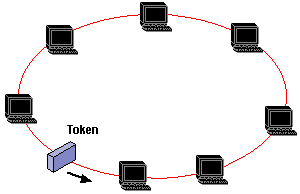In 1984, IBM introduced the 4 Mbit/s Token Ring network. Instead of the normal plug and socket arrangement of male and female gendered connectors, the IBM data connector (IDC) was a sort of hermaphrodite, designed to mate with itself. Although the IBM Cabling System is to this day regarded as a very high quality and robust data communication media, its large size and cost – coupled with the fact that with only 4 cores it was less versatile than 8-core UTP – saw Token Ring continue fall behind Ethernet in the popularity stakes. It remains IBM’s primary LAN technology however and the compatible and almost identical IEEE 802.5 specification continues to shadow IBM’s Token Ring development.
The difference between Token Ring and IEEE 802.5 networks are minor. IBM’s Token Ring network specifies a star, with all end stations attached to a device called a multistation access unit (MSAU). In contrast, IEEE 802.5 does not specify a topology, although virtually all IEEE 802.5 implementations are based on a star.

When a Token Ring network starts up, the nodes all take part in a negotiation to decide who will control the ring, or become the Active Monitor – responsible for making sure that none of the members are causing problems on the network, and for re-establishing the ring after a break or if an error has occurred. To do this it performs Ring Polling every few seconds and ring purges whenever it detects a problem. The former allows all nodes on the network to find out who is participating in the ring and to learn the address of their Nearest Active Upstream Neighbour (NAUN), necessary to allow nodes to enter or leave the ring. Ring purges reset the ring after an interruption or loss of data is reported.
Token Ring networks work by transmitting data in tokens, which are passed along the ring in a unidirectional manner and viewed by each node. When a node sees a message addressed to it, it copies the message and marks that message as being read. As the message makes its way along the ring, it eventually gets back to the sender who notes that the message was received successfully and removes it. Possession of the token grants the right to transmit. If a node receiving the token has no information to send, it passes the token to the next node in the ring. Each node is allowed to hold the token for some maximum period of time.
In 1997 the High-Speed Token Ring Alliance (HSTR) was created with the dual goals of establishing a specification and seeing some of its members ship 100 Mbit/s token-ring products. Notwithstanding the fact that 1999 saw both of these goals achieved, the absence of any commitment to Gigabit capability from the major proponents of Token Ring appeared to indicate that they were finally ready to concede defeat to the rival Ethernet technology
When a Token Ring network starts up, the nodes all take part in a negotiation to decide who will control the ring, or become the Active Monitor – responsible for making sure that none of the members are causing problems on the network, and for re-establishing the ring after a break or if an error has occurred. To do this it performs Ring Polling every few seconds and ring purges whenever it detects a problem. The former allows all nodes on the network to find out who is participating in the ring and to learn the address of their Nearest Active Upstream Neighbour (NAUN), necessary to allow nodes to enter or leave the ring. Ring purges reset the ring after an interruption or loss of data is reported.
Token Ring networks work by transmitting data in tokens, which are passed along the ring in a unidirectional manner and viewed by each node. When a node sees a message addressed to it, it copies the message and marks that message as being read. As the message makes its way along the ring, it eventually gets back to the sender who notes that the message was received successfully and removes it. Possession of the token grants the right to transmit. If a node receiving the token has no information to send, it passes the token to the next node in the ring. Each node is allowed to hold the token for some maximum period of time.
In 1997 the High-Speed Token Ring Alliance (HSTR) was created with the dual goals of establishing a specification and seeing some of its members ship 100 Mbit/s token-ring products. Notwithstanding the fact that 1999 saw both of these goals achieved, the absence of any commitment to Gigabit capability from the major proponents of Token Ring appeared to indicate that they were finally ready to concede defeat to the rival Ethernet technology
- OSI Model
- Network Topologies
- FDDI Networking
- Token Ring Networks
- Ethernet
- Fast Ethernet
- Gigabit Ethernet
- Peer to Peer Network Architecture
- Client/Server Architecture
- P2P Networking
- Network Hardware
- NIC Cards
- Hubs and Repeaters
- Bridges
- Routers
- Network Switches
- Network Transceivers
- Cabling
- Home Networking
- Ethernet Networks
- Phone-line Networks
- Power-line Networks
- IEEE 802.11
- Wireless Networks
- Technology Comparison